2018 PEUGEOT 3008 parking brake
[x] Cancel search: parking brakePage 227 of 360

225
Snow chains
In wintry conditions, snow chains
improve traction as well as the
behaviour of the vehicle when
braking.
Snow chains must be fitted only to the
front wheels. They must never be fitted to
"space-saver" type spare wheels.
Take account of the legislation in force in
your country on the use of snow chains
and the maximum authorised speed.
Use only the chains designed to be fitted to the
type of wheel fitted to your vehicle:
Installation tips
F If you have to fit the chains during a journey, stop the vehicle on a flat sur face on the side
of the road.
F
A
pply the parking brake and position any
wheel chocks to prevent movement of your
vehicle.
F
F
it the chains following the instructions
provided by the manufacturer.
F
M
ove off gently and drive for a few
moments, without exceeding 31
mph
(50
km/h).
F
S
top your vehicle and check that the snow
chains are correctly tightened.
It is strongly recommended that before
you leave, you practise fitting the snow
chains on a level and dry sur face.
Original tyre size Maximum link size
215/65
R17 9
mm
225/55
R18 9
mm
205/55
R19 9
mm
235/50
R19
cannot be fitted with chains
For more information on snow chains, contact a
PEUGEOT dealer or a qualified workshop. Avoid driving with snow chains on roads
that have been cleared of snow to avoid
damaging your vehicle's tyres and the
road sur face. If your vehicle is fitted with
alloy wheels, check that no part of the
chain or its fixings is in contact with the
wheel rim.Fitting roof bars
As a safety measure and to avoid
damaging the roof, it is essential to use
the transverse bars approved for your
vehicle.
Obser ve the instructions on fitting and
use contained in the guide supplied with
the roof bars.
Fitting on longitudinal bars
The transverse bars must be fixed at the
engraved markings on the longitudinal bars.
7
Practical information
Page 234 of 360
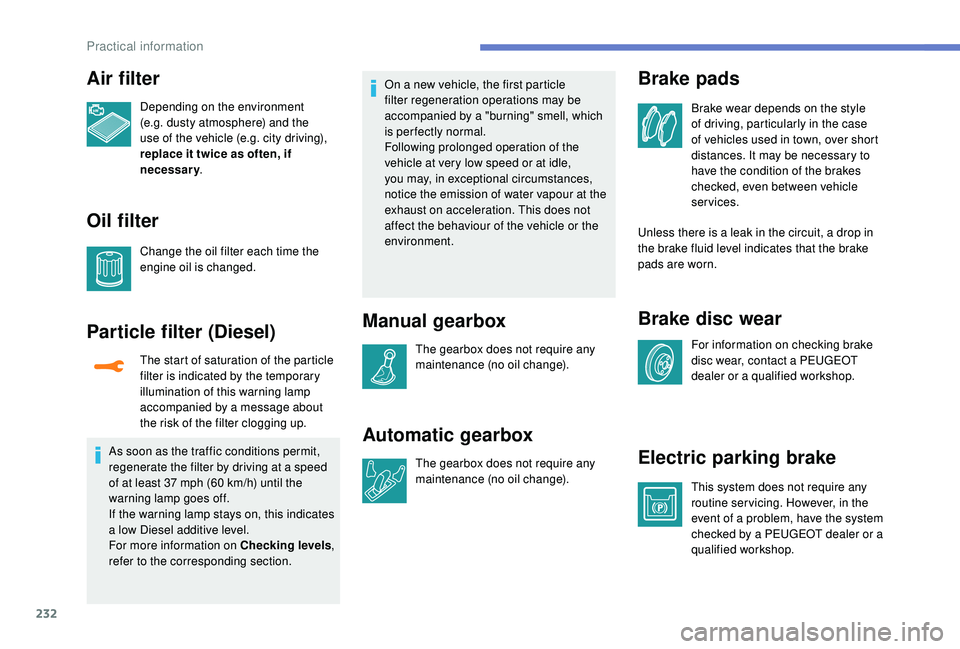
232
Air filter
Depending on the environment
(e.g. dusty atmosphere) and the
use of the vehicle (e.g. city driving),
replace it twice as often, if
necessary.
Oil filter
Change the oil filter each time the
engine oil is changed.
Particle filter (Diesel)
The start of saturation of the particle
filter is indicated by the temporary
illumination of this warning lamp
accompanied by a message about
the risk of the filter clogging up.
As soon as the traffic conditions permit,
regenerate the filter by driving at a speed
of at least 37
mph (60 km/h) until the
warning lamp goes off.
If the warning lamp stays on, this indicates
a low Diesel additive level.
For more information on Checking levels ,
refer to the corresponding section. On a new vehicle, the first particle
filter regeneration operations may be
accompanied by a "burning" smell, which
is per fectly normal.
Following prolonged operation of the
vehicle at very low speed or at idle,
you may, in exceptional circumstances,
notice the emission of water vapour at the
exhaust on acceleration. This does not
affect the behaviour of the vehicle or the
environment.
Manual gearbox
The gearbox does not require any
maintenance (no oil change).
Automatic gearbox
The gearbox does not require any
maintenance (no oil change).
Brake pads
Brake wear depends on the style
of driving, particularly in the case
of vehicles used in town, over short
distances. It may be necessary to
have the condition of the brakes
checked, even between vehicle
services.
Unless there is a leak in the circuit, a drop in
the brake fluid level indicates that the brake
pads are worn.
Brake disc wear
For information on checking brake
disc wear, contact a PEUGEOT
dealer or a qualified workshop.
Electric parking brake
This system does not require any
routine servicing. However, in the
event of a problem, have the system
checked by a PEUGEOT dealer or a
qualified workshop.
Practical information
Page 235 of 360
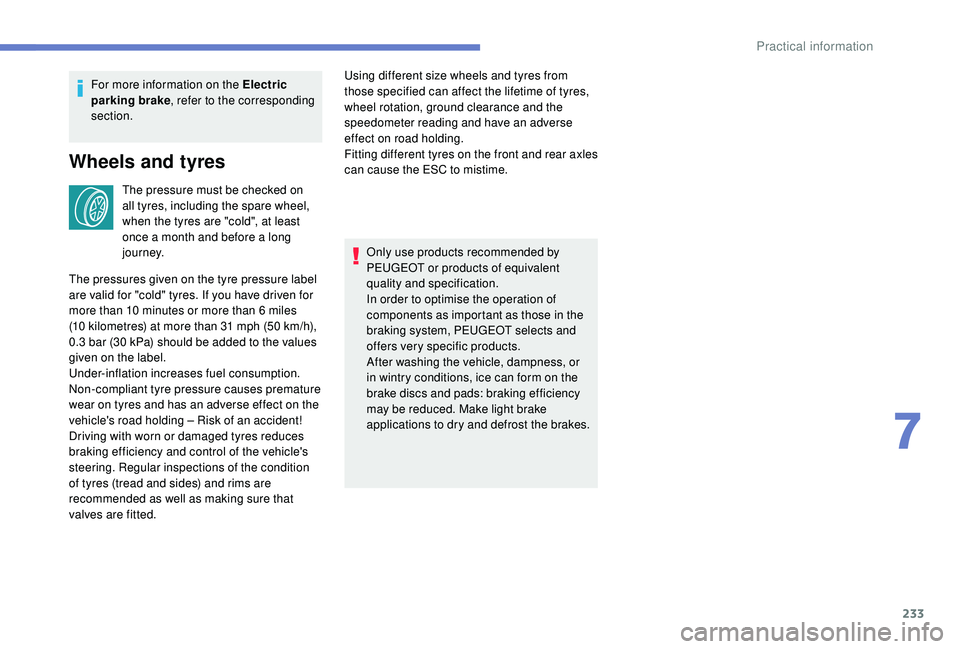
233
For more information on the Electric
parking brake, refer to the corresponding
section.
Wheels and tyres
The pressure must be checked on
all tyres, including the spare wheel,
when the tyres are "cold", at least
once a month and before a long
j o u r n ey. Using different size wheels and tyres from
those specified can affect the lifetime of tyres,
wheel rotation, ground clearance and the
speedometer reading and have an adverse
effect on road holding.
Fitting different tyres on the front and rear axles
can cause the ESC to mistime.
Only use products recommended by
PEUGEOT or products of equivalent
quality and specification.
In order to optimise the operation of
components as important as those in the
braking system, PEUGEOT selects and
offers very specific products.
After washing the vehicle, dampness, or
in wintry conditions, ice can form on the
brake discs and pads: braking efficiency
may be reduced. Make light brake
applications to dry and defrost the brakes.
The pressures given on the tyre pressure label
are valid for "cold" tyres. If you have driven for
more than 10
minutes or more than 6 miles
(10
kilometres) at more than 31 mph (50 km/h),
0.3
bar (30 kPa) should be added to the values
given on the label.
Under-inflation increases fuel consumption.
Non-compliant tyre pressure causes premature
wear on tyres and has an adverse effect on the
vehicle's road holding
– Risk of an accident!
Driving with worn or damaged tyres reduces
braking efficiency and control of the vehicle's
steering. Regular inspections of the condition
of tyres (tread and sides) and rims are
recommended as well as making sure that
valves are fitted.
7
Practical information
Page 242 of 360
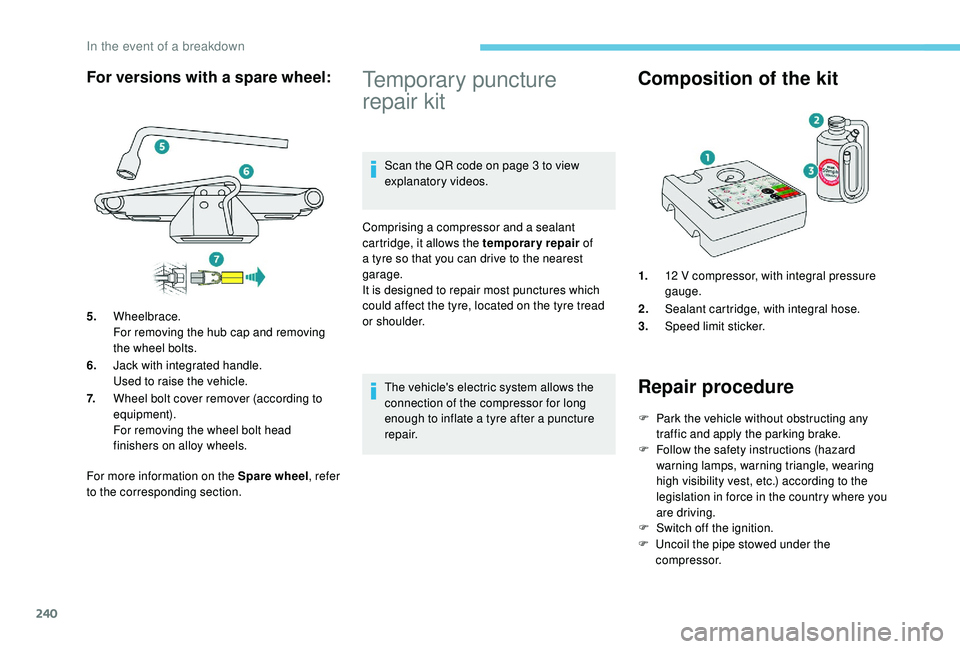
240
For more information on the Spare wheel, refer
to the corresponding section.
Temporary puncture
repair kit
Scan the QR code on page 3 to view
explanatory videos.
Comprising a compressor and a sealant
cartridge, it allows the temporary repair of
a tyre so that you can drive to the nearest
garage.
It is designed to repair most punctures which
could affect the tyre, located on the tyre tread
or shoulder.
The vehicle's electric system allows the
connection of the compressor for long
enough to inflate a tyre after a puncture
repair.
Composition of the kit
1. 12 V compressor, with integral pressure
gauge.
2. Sealant cartridge, with integral hose.
3. Speed limit sticker.
Repair procedure
F Park the vehicle without obstructing any
traffic and apply the parking brake.
F
F
ollow the safety instructions (hazard
warning lamps, warning triangle, wearing
high visibility vest, etc.) according to the
legislation in force in the country where you
are driving.
F
S
witch off the ignition.
F
U
ncoil the pipe stowed under the
compressor.
For versions with a spare wheel:
5. Wheelbrace.
For removing the hub cap and removing
the wheel bolts.
6. Jack with integrated handle.
Used to raise the vehicle.
7. Wheel bolt cover remover (according to
equipment).
For removing the wheel bolt head
finishers on alloy wheels.
In the event of a breakdown
Page 247 of 360
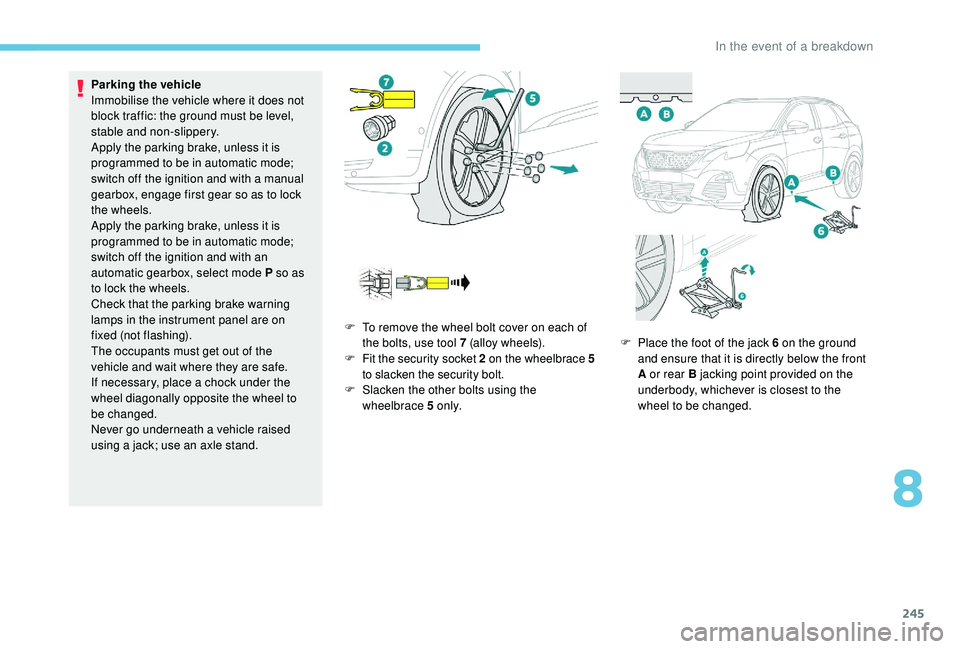
245
Parking the vehicle
Immobilise the vehicle where it does not
block traffic: the ground must be level,
stable and non-slippery.
Apply the parking brake, unless it is
programmed to be in automatic mode;
switch off the ignition and with a manual
gearbox, engage first gear so as to lock
the wheels.
Apply the parking brake, unless it is
programmed to be in automatic mode;
switch off the ignition and with an
automatic gearbox, select mode P so as
to lock the wheels.
Check that the parking brake warning
lamps in the instrument panel are on
fixed (not
flashing).
The occupants must get out of the
vehicle and wait where they are safe.
If necessary, place a chock under the
wheel diagonally opposite the wheel to
be changed.
Never go underneath a vehicle raised
using a jack; use an axle stand. F
T
o remove the wheel bolt cover on each of
the bolts, use tool 7 (alloy wheels).
F
F
it the security socket 2 on the wheelbrace
5
to slacken the security bolt.
F
S
lacken the other bolts using the
wheelbrace 5 o n l y. F
P
lace the foot of the jack 6 on the ground
and ensure that it is directly below the front
A or rear B jacking point provided on the
underbody, whichever is closest to the
wheel to be changed.
8
In the event of a breakdown
Page 263 of 360
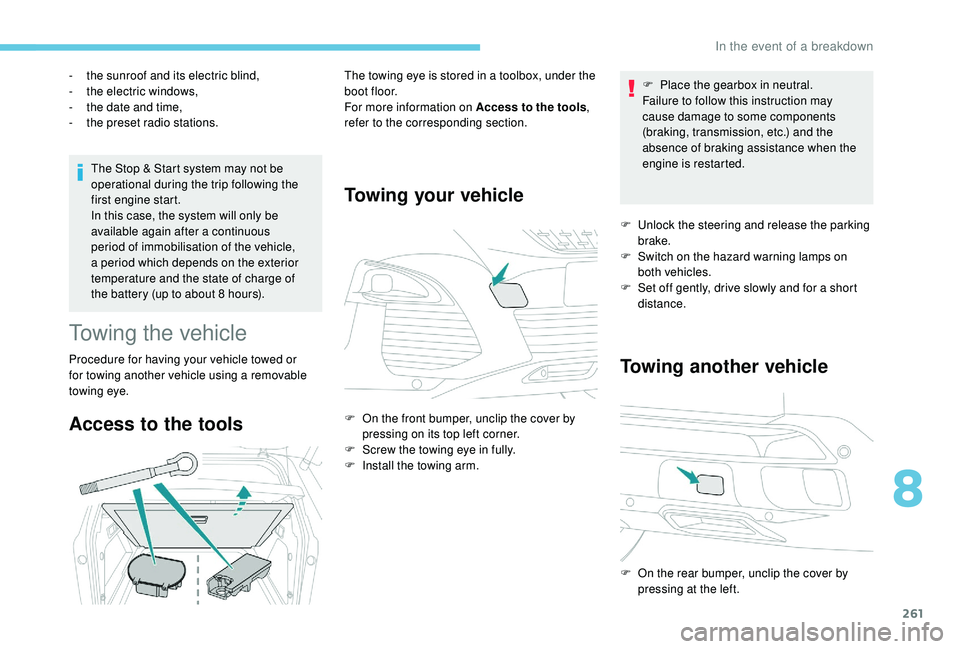
261
The Stop & Start system may not be
operational during the trip following the
first engine start.
In this case, the system will only be
available again after a continuous
period of immobilisation of the vehicle,
a period which depends on the exterior
temperature and the state of charge of
the battery (up to about 8 hours).
-
t
he sunroof and its electric blind,
-
t
he electric windows,
-
t
he date and time,
-
t
he preset radio stations.
Towing the vehicle
Procedure for having your vehicle towed or
for towing another vehicle using a removable
towing eye.
Access to the tools
The towing eye is stored in a toolbox, under the
boot floor.
For more information on Access to the tools
,
refer to the corresponding section.
Towing your vehicle
F On the front bumper, unclip the cover by pressing on its top left corner.
F
S
crew the towing eye in fully.
F
I
nstall the towing arm. F
P
lace the gearbox in neutral.
Failure to follow this instruction may
cause damage to some components
(braking, transmission, etc.) and the
absence of braking assistance when the
engine is restarted.
F
U
nlock the steering and release the parking
brake.
F
S
witch on the hazard warning lamps on
both vehicles.
F
S
et off gently, drive slowly and for a short
distance.
Towing another vehicle
F On the rear bumper, unclip the cover by pressing at the left.
8
In the event of a breakdown
Page 264 of 360
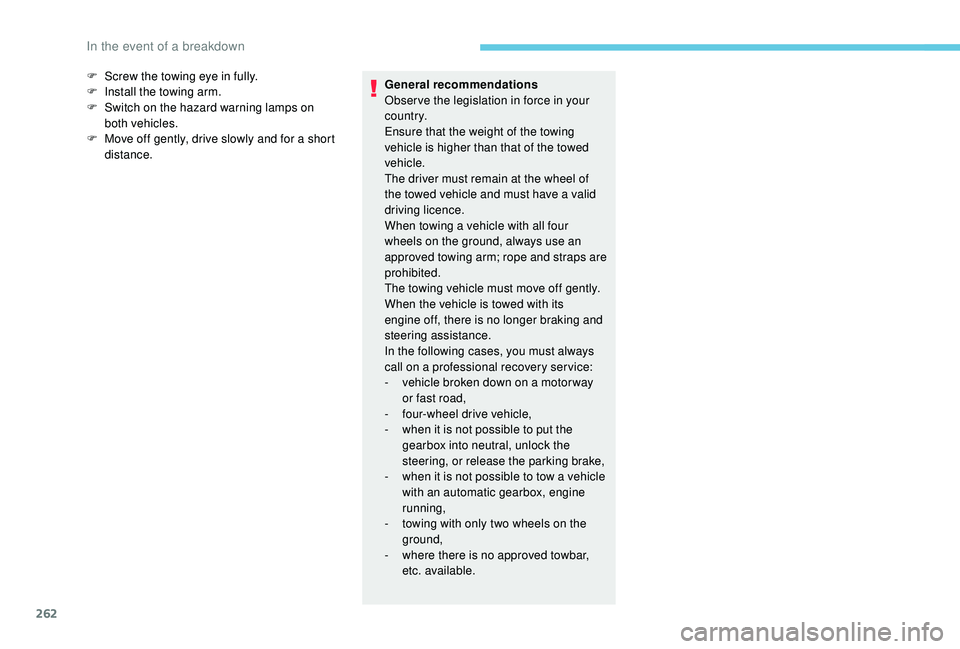
262
F Screw the towing eye in fully.
F I nstall the towing arm.
F
S
witch on the hazard warning lamps on
both vehicles.
F
M
ove off gently, drive slowly and for a short
distance. General recommendations
Obser ve the legislation in force in your
c o u nt r y.
Ensure that the weight of the towing
vehicle is higher than that of the towed
vehicle.
The driver must remain at the wheel of
the towed vehicle and must have a valid
driving licence.
When towing a vehicle with all four
wheels on the ground, always use an
approved towing arm; rope and straps are
prohibited.
The towing vehicle must move off gently.
When the vehicle is towed with its
engine off, there is no longer braking and
steering assistance.
In the following cases, you must always
call on a professional recovery ser vice:
-
v
ehicle broken down on a motor way
or fast road,
-
f
our-wheel drive vehicle,
-
w
hen it is not possible to put the
gearbox into neutral, unlock the
steering, or release the parking brake,
-
w
hen it is not possible to tow a vehicle
with an automatic gearbox, engine
running,
-
t
owing with only two wheels on the
ground,
-
w
here there is no approved towbar,
etc. available.
In the event of a breakdown
Page 353 of 360

269
Massage function ...........................................76
M assage, multi-point ...................................... 76
Mat
......................................................... 101-102
Memorising a speed
..................................... 17
2
Menu
............................................................... 12
Menu, main
....................................................... 4
M
enus (audio)
........................................ 3-5, 4-5
Messages
........................................................ 28
Messages, quick
............................................. 28
M
irror, rear view ......................................... 7 7-78
Mirrors, door ......................... 76 -77, 91, 200-201
Mirror, vanity
................................................... 97
Misfuel prevention
.................................. 216 -217
Motorised tailgate
..................................... 6
2- 64
Mountings, ISOFIX
....................................... 143
MP3 CD
............................................................. 9
N
Net, high load retaining .................................107
Number plate lamps ...................................... 252
O
Obstacle detection ........................................ 202
Oil change ............................................. 2
29-230
Oil consumption
.................................... 229-230
Oil, engine
....................................... 12, 229-230
On-board tools
.............................. 108, 238-240
Opening the bonnet
..............................226-227
Opening the boot
...................................... 51, 61
Opening the doors
.................................... 51, 60
Opening the fuel filler flap
.............................216
Opening the windows
..................................... 48
L
Labels, identification ..................................... 269
Lamp, boot .................................................... 108
Lamps, parking
............................................. 111
Lamps, rear
................................................... 250
Lane Departure Warning System (LDWS)
.................................... 17, 19 4
Lane Departure Warning System (LDWS), Active
................17, 195 , 202
LEDs
– Light-emitting diodes
.......111,
248, 250
Level, brake fluid
........................................... 230
Level, Diesel additive
.............................231-232
Level, engine coolant
..............................32, 230
Level, engine oil
.............................. 31, 229-230
Levels and checks
..............................
..228 -231
Level, screenwash fluid
........................11
8, 231
Light-emitting diodes
– LEDs
.......111,
248, 250
Lighting
............................................................ 26
Lighting, cornering
................................. 11 6 -117
Lighting dimmer
.............................................. 36
Lighting, exterior
........................................... 109
Lighting, guide-me home
.................50, 113 -114
Lighting, interior
...............................
......102-103
Lighting, mood
........................................ 36, 103
Lighting, welcome
......................................... 113
Loading
......................................... 107, 225-226
Load reduction mode
.................................... 223
Locating your vehicle
...................................... 50
Locking
...............................
................49, 52 , 54
Locking from the inside
...................................57
Locking the doors
........................................... 62
L
ong objects, transporting
............................105
Low fuel level
................................................ 2
16
M
Map reading lamps ................................10 2-103
Markings, identification .................................269
I
i- Cockpit amplify
function ...............76, 80 - 81 , 10 0 -101 , 166 -167
Ignition
................
............................. 15 4, 15 6 , 28
Ignition on ...................................................... 15 6
Immobiliser, electronic
............................54, 152
Indicator, AdBlue
® range ................................. 32
Indicator, coolant temperature ........................ 32
Indicator, engine oil level
.......................... 31, 35
Indicator lamps, operation
........................ 11,
15
Indicators, direction
.............................. 111, 249
Inflating tyres
................................................ 233
Inflating tyres (using the kit)
.................. 24
0, 242
Instrument panel
................................ 8-9, 35 -37
Intelligent Traction Control
............................ 125
Internet browser
.............................................. 16
I
SOFIX
.......................................................... 14 4
ISOFIX mountings ......................................... 143
J
Jack .....................................239 -240 , 243, 23, 9
Jump starting ................................................ 258
K
Key ........................................................... 48, 54
Key, electronic ............................................ 51- 5 2
Keyless Entry and Starting ....51 - 5 2, 54 , 15 4 -15 5Key not recognised ................................ 15 6 -157
Key with remote control ................................15
2
Kit, hands-free
.................... 2
5 -26, 13 -14 , 1 0 -11
Kit, temporary puncture repair
...... 2
38-240, 242
.
Alphabetical index